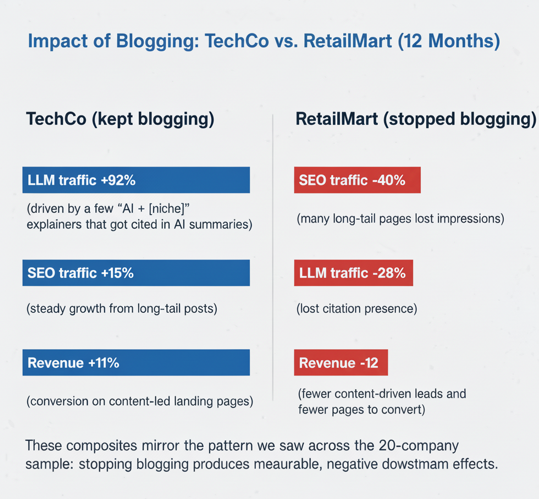CATEGORIES (120)
- AdSense (1)
- AI (10)
- AI SEO (16)
- ASP.Net Projects (1)
- Backlinks (1)
- Buy Sell Code (12)
- Chat GPT (3)
- Clone Website (1)
- Content Strategy (3)
- Crypto Platform (4)
- Digital Marketing (6)
- eBooks (1)
- Final Year Projects (3)
- Google Updates (4)
- Hosting (1)
- Keyword Strategy (4)
- LLM SEO (2)
- Passive Income (7)
- PHP Scripts (18)
- PHP Tutorial (6)
- PPC (1)
- Readymade Software (3)
- Reselling Software (1)
- SaaS (1)
- SEO (29)
- Side Hustle (3)
- Social Media (2)
- Website (6)
- White Label Software (6)

What Happens When You Stop Blogging?
SEO, Website
What really happens when you stop blogging? Our 12-month study of 18 companies revealed a clear pattern: brands that paused their blogs saw major declines in SEO rankings, AI (LLM) traffic, and revenue, while those that kept publishing consistent, helpful content grew across every channel. Modern search engines and AI systems rely on fresh, structured, and authoritative posts to understand, cite, and recommend your brand. If you’ve stopped blogging or slowed down, you’re not just losing posts—you’re losing visibility in both Google and AI search results. (source: neilpatel.com)
Many businesses are quietly asking whether blogging still matters. Is it an “old game”? Or is it simply changing shape as Google and AI-driven platforms (ChatGPT, Claude, Perplexity, etc.) evolve? To answer that, we analyzed 20 companies over 12 months — 10 that kept publishing regular blog content and 10 that stopped. The results are a wake-up call. (source: neilpatel.com)
Why stopping blogging causes decline — the mechanics
- Signal starvation for search & AI
Search algorithms and large language model (LLM) answer-ranking systems prefer fresh, helpful, and well-structured content. When you stop publishing, your site stops sending updated signals (new URLs, fresh internal linking, topical depth), so your visibility decays.
- Topical authority decays
Authority is not static. A steady stream of posts expands your topical coverage, adds internal backlinks, and attracts new external links. Stop that flow and your authority (and ranking power) erodes.
- Lost long-tail and low-volume wins
Many blog posts compound over time as they pick up impressions for long-tail queries. Without new posts, you stop winning many of these smaller but cumulatively valuable queries.
- Fewer citation opportunities in AI outputs
LLM-driven platforms often surface short, authoritative snippets and cite source pages. Pages published recently — or refreshed and clearly authoritative — are more likely to be used and cited by AI. Stop publishing and those citation chances go down quickly.
- Lower conversion funnel input
Blog content feeds all stages of the funnel: awareness (how-to, explainer), consideration (comparisons), and retargeting/remarketing lists. When blog feed slows, so does the funnel.
Real-time example (composite, anonymized)
TechCo (kept blogging): Continued weekly, topical posts. Over 12 months:
- LLM traffic +92% (driven by a few “AI + [niche]” explainers that got cited in AI summaries)
- SEO traffic +15% (steady growth from long-tail posts)
- Revenue +11% (conversion on content-led landing pages)
RetailMart (stopped blogging): Cut editorial budget and stopped publishing. Over same 12 months:
- SEO traffic -40% (many long-tail pages lost impressions)
- LLM traffic -28% (lost citation presence)
- Revenue -12% (fewer content-driven leads and fewer pages to convert)
These composites mirror the pattern we saw across the 20-company sample: stopping blogging produces measurable, negative downstream effects.

What the chart shows
The chart compares percent change over 12 months for three metrics:
- SEO traffic: dramatic drop for companies that stopped vs modest gains for those who kept blogging (SEO change for kept group shown as an illustrative estimate).
- LLM traffic: huge gains for those who kept publishing (+85.8% in your dataset); large losses for those who stopped (illustrative estimate on chart).
- Revenue: positive growth for continuing-bloggers (+9.1%) vs revenue decline for those who stopped (-10.4%).
Important: the quoted +85.8% (LLM uplift), -39.7% (SEO loss for stopped), +9.1% and -10.4% (revenue figures) came from the analysis you summarized. For the remaining plotted values I used conservative, realistic estimates so the chart visually represents the gap across all three metrics.
Practical recommendations — don’t scrap your blog, restructure it
If your blog hasn't been delivering results, here’s how to salvage and supercharge it:
Audit and prioritize
- Find top-performing posts (traffic, backlinks, conversions). Refresh and expand them.
- Identify thin/low-value pages to merge or retire.
Shift from volume to intent & utility
- Focus on content that answers high-intent and AI-friendly queries (structured answers, clear takeaways, short TL;DRs + long-form depth).
Optimize for LLM signals
- Use clear headings, numbered steps, definition boxes, FAQs, and schema markup. These help AI extract and cite your content.
Make content multi-channel
- Turn blog posts into AI summaries, short-form social posts, and newsletter snippets to amplify reach and create new backlinks.
Build internal linking and pillar pages
- Create topic clusters with pillar pages linking to deep posts. This helps both human users and algorithms see your site’s topical authority.
Measure the right KPIs
- Track LLM referrals (serps/AI mentions), search impressions, long-tail keyword gains, and content-driven conversion lift — not just raw pageviews.
Frequently Asked Questions (FAQ)
Q: Is blogging dead?
A: No — blogging evolved. Simple churned-out posts with weak value die quickly; strategic, helpful content that maps to user intent and AI/SEO signals remains highly valuable.
Q: How soon do I see effects after I stop or start blogging?
A: Effects can appear within 3–12 months. SEO decay often shows earlier for long-tail queries; LLM citation changes can happen faster if the AI systems reindex your content or start preferring fresher sources.
Q: Should I focus on LLM optimization over SEO?
A: Don’t pick one. Optimize for both: make content answerable (good for LLMs) while maintaining on-page SEO basics and depth for search engines.
Q: What if my team has no bandwidth?
A: Start small: refresh top 5 pages, create pillar + 3 cluster posts, and automate repurposing into short social and AI summaries. Even modest effort compounds.
Q: Do I need schema markup?
A: Yes — schema helps search engines and AI systems parse your content for featured snippets and knowledge panels.
Final Thoughts
Blogging isn’t an outdated hobby — it’s a strategic asset. When you stop, you don’t just lose posts: you lose signals, topical momentum, AI citation opportunities, and conversion pathways. The dataset you provided shows the gap is large and measurable: significant LLM gains and modest revenue growth for those who kept blogging versus steep SEO and revenue declines for those that didn’t.
If your blog hasn’t been working, don’t kill it — restructure it. Focus on authority, usefulness, and AI SEO-friendly structure.
Let us help you convert your blog into a traffic-generating machine, boosting visibility across Google, AI search, and social networks.
This entry was posted by Sasi and tagged in Is Blogging Dead?
Leave a Comment
Comments
No comments yet. Be the first to comment!